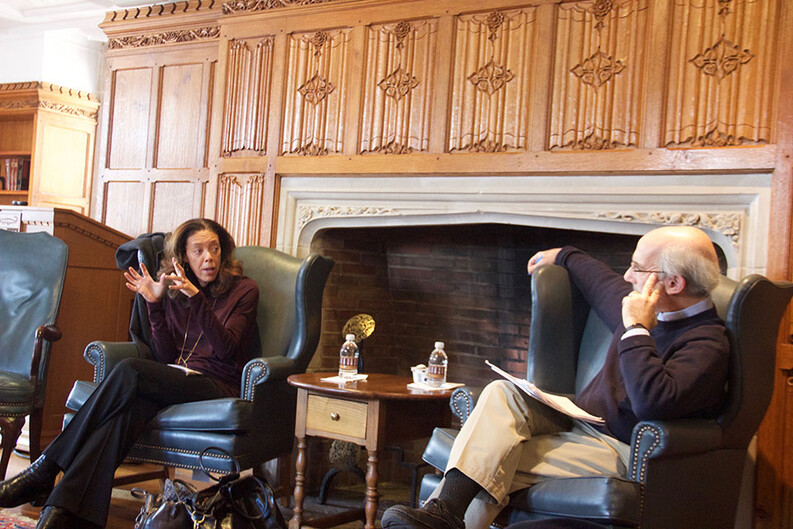Human Rights Workshop: Ginger Thompson on Reporting at the U.S.-Mexico Border

At the Human Rights Workshop on November 14, 2019, ProPublica Senior Reporter Ginger Thompson spoke about her investigative journalism at the U.S.-Mexico border, which sparked a massive public outcry that forced the Trump administration to retreat from their family separation policy.
Thompson’s coverage of the border focused on the human cost of the Trump administration’s 2018 “zero-tolerance” immigration policy, which sought to discourage undocumented migrants and asylum seekers from entering the country. Under this policy, the Department of Justice criminally prosecuted families crossing the border without papers, with no exception for asylum seekers or those with minor children. Adult migrants were separated from their children to be detained in adult-only federal criminal facilities, while their children were held in separate detention centers.
Thompson explained that she “didn’t go looking for” her breaking news story on the “zero tolerance” policy. Instead, it “came to her” through a source with whom she has built a relationship over the past 30 years.
On a Friday evening after work, Thompson received a phone call from a former colleague who knew attorney Jennifer Harbury had an audio recording of Central American migrant children’s voices and cries after having been separated from their parents at the U.S.-Mexico border. Before publishing a piece about this audio recording, Thompson said, she had to “authenticate it, get permission to use it, and identify who recorded it.” Listening to the tape closely, Thompson could make out a child’s voice asking authorities at a U.S. Customs and Border Patrol facility for a phone call. In doing so, the child articulated her aunt’s phone number aloud, which gave Thompson a lead. Getting in contact with the six-year-old Salvadoran girl’s aunt in Houston was enough to authenticate the tape, Thompson said.
Before publishing the tape, Harbury wanted to “cut parts of the tape out” in which the voice of the person recording the tape could be heard. Aware of the tape’s “potential power,” Thompson refused to edit it to avoid any accusations of having manipulated the audio. Harbury subsequently allowed her to use the entire audio recording, she said.
By Monday afternoon, the story on the tape was published. Thompson described how the sound filled the White House press briefing room that day, playing from a chorus of reporters’ phones. At the press briefing, Thompson said, a government official summoned the Department of Homeland Security Secretary in light of the tape’s release. Thompson said the tape was played “on the floor of Congress the next day and in protest in front of a Trump hotel.” Forty-eight hours after the story was published, Trump announced that he would “reverse the child separation part of the ‘zero tolerance’ policy.” Migrants and asylum-seekers would still be criminally prosecuted, but no more children would be separated from their families, according to Trump’s announcement.
In her presentation, Thompson reflected on the “thin line between public service reporting and advocacy.” While many questioned whether Thompson was acting as an advocate through her reporting, Thompson argued that an “advocate would have fought for the legal rights of that child [on the tape] as an individual.” Instead, Thompson and other journalists “look at the cases they write about to tell a larger truth, to get to the heart of this policy.”
In addition, Thompson emphasized her commitment to journalistic ethics that do not necessarily constrain advocates. “It’s not only that reporting has an important role in public service and in exposing harm and empowering people with knowledge, but there are certain lines that we can’t cross — which is why we didn’t edit the tape,” Thompson explained. She needed to talk to her sources and protect their interests in a way that presented the story in its “full and factual form.”
Despite Trump’s announcement that he would stop separating families at the border, Thompson said, “there was no plan for putting [the families] back together” of the “more than 2,000 kids who had already been separated from their parents. Thompson continued to pursue the story, talking to lawyers, advocates, and parents in detention, and she began spending “a lot of time in detention facilities.”
During this time, she met a father in detention whose son, Brian, had been separated from him in September 2018. This was the “first story that indicated the government was still separating children from their parents,” Thompson said. Brian’s father knew his son was in New York, so Thomspon reached out to her network of New York advocates and was able to locate Brian in a shelter.
Thompson discussed how Border Patrol agents “accused Brian’s father of being a gang member” and separated the two with “no child welfare training and no authority to look at Salvadoran documents to see if he was actually a criminal.” Enforcement of immigration policy, Thompson said, was “based on their discretion.” Trump’s apparent reversal therefore did not actually stop agents from separating families when they chose to.
Thompson also recounted the story of Wilder, a Salvadoran boy who came to the U.S. with his father but was separated from him at the border. After staying with a foster family for several months — living in a “middle-class, loving, happy home” — he was deported with his father back to their “small village in El Salvador without running water.” This story, Thompson said, was “complicated to see and write.” Her objective, though, was to show “how the U.S. had put a wedge that had changed the way this child saw his family.” She focused on the “trauma these kids suffer in their journeys to the States, in their separations from parents, and in their return to their homelands.”
“There is just trauma at every turn in this process,” Thompson said. “One child’s story was the most effective way of explaining the impact this [policy] was having on [all of these] children.” She wanted to help “the country really see beyond what we were doing in the border and how it was affecting children.”


